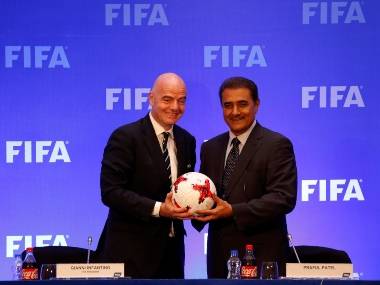
World governing body FIFA has sought an update from the All India Football Federation (AIFF) on the domestic turmoil surrounding the merger of two leagues into one top-tier national championship.
The AIFF’s plan to merge the franchise-based Indian Super League (ISL) with the I-League has faced major obstacles and there is little clarity on the roadmap, leaving stakeholders and fans confused about the future of club football.
The All India Football Federation (AIFF) secretary Kushal Das on Friday stressed that the Federation would need time to implement the ‘Road Map’ for an “integrated league” suggested by the Asian Football Confederation in 2018. “It won’t happen overnight. We may need a three-year period to tackle the participation agreement which is the stumbling block,” he said.
Das assured that steps were being taken to handle the situation arising out of six I-League clubs’ protest against the move to make the franchise-based Indian Super League as the main competition.
According to the AFC ‘Road Map’ – authored by Alex Phillips, Head of Asia-Europe Affairs, AFC and Nic Coward, a professional football consultant with FIFA – issued to the AIFF on February 2, 2018, both the Indian Super League (ISL) and the I-League were allowed to run parallelly only till the 2018-19 season “on the strict condition that there is concrete agreement to the implementation of the Road Map for the unified system from 2019-20 season and beyond.”
The consequence of not having a unified league by the 2019-20 season would be “the removal of India from qualification for AFC Club Competitions.”
The AIFF president Praful Patel, however, has mentioned that he will approach the confederation for a three-year extension for the implementation of the ‘Road Map’.
The other points listed out in the Road Map are:
At the conclusion of 2018-19 season, the top teams from ISL and I-League to play of for the Indian Championship title, and all 2020 AFC Club Competition places.
A unified national Tier 1 to start with 12 teams in 2019-20, with presumption that the current 10 ISL teams will form 10 of the 12 Tier 1 teams in 2019-20.
The two additional teams will be either:
(a) one through sporting path as I-League champions 2018-19, and one through open tender process on transparent basis of criteria (e.g. key market/football development/financial investment)
(b) two through sporting path as 2018-19 I-League champions and runners up.
A clear promotion link is necessary to invigorate the second tier, and therefore create serious competition amongst the clubs in Tier 2, with this same approach continuing through the system.
If this was implemented for the coming season, I-League champion Chennai City FC, along with runner up East Bengal or a new franchise entrant, would have been a part of ISL season 6.
2019-20 season qualification for AFC Club Competitions from league sporting success to be from Tier 1 only.
At the conclusion of the 2019-20 season, two additional teams to be added to Tier 1 so that there are 14 clubs in the 2020-21 season, using the same method as outlined above.
Tier 1 club Reserve/Youth teams have to play in season-long competitions with open age State Association clubs, to raise standards and to promote football development.
Tier 1 to increase to 16 teams in 2021-22 (which would be the number at which Tier 1 would then operate into the long-term). At the end of the 2021-22 season, there would be promotion and relegation of 2 up/2 down.
National Tier 2 to start with 12 teams in 2019-20, and to increase to 16 teams thereafter in parallel with Tier 1, using similar expansion method as for Tier 1.
Top 2 tiers to operate home and away league system. Overall season length for all Tiers to be from Sept/Oct to Apr/May.
Tier 3 and State Association Leagues
The Road Map also stresses on the significant need for the creation of competition between national and state league competitions. Until the national Tier 3 league can be established on a sustainable basis, it will be operated on a regional basis which will act as the bridge between the best state-level teams and Tier 2.
It also states that addressing State Associations is “a priority for the AIFF” in building the football ecosystem in the country.
Cup competition
AIFF launched the Super Cup in 2018 as the successor to the Federation Cup and it has since become the de facto League Cup in the country. Since then, the tournament was conducted after the conclusion of both ISL and I-League seasons. The Road Map, however, recommends “the national cup competition takes place during the league season, not after.”
The knockout competition will include Tiers 1, 2 and 3/State Association champions with the winner qualifying for the AFC Cup. It also states that all clubs are “contractually obliged to participate, on a full team strength basis.”
